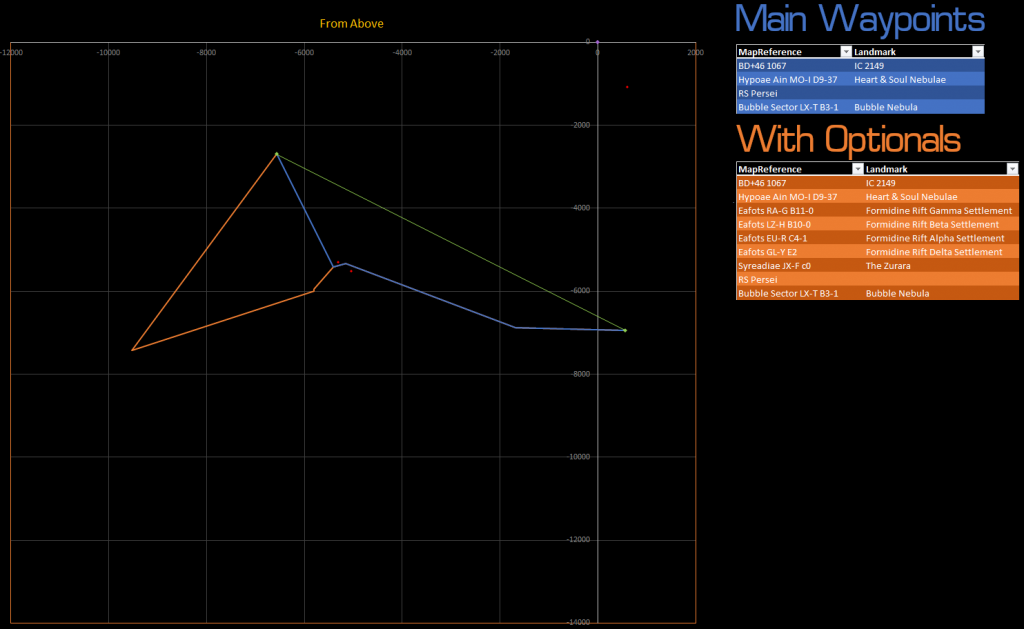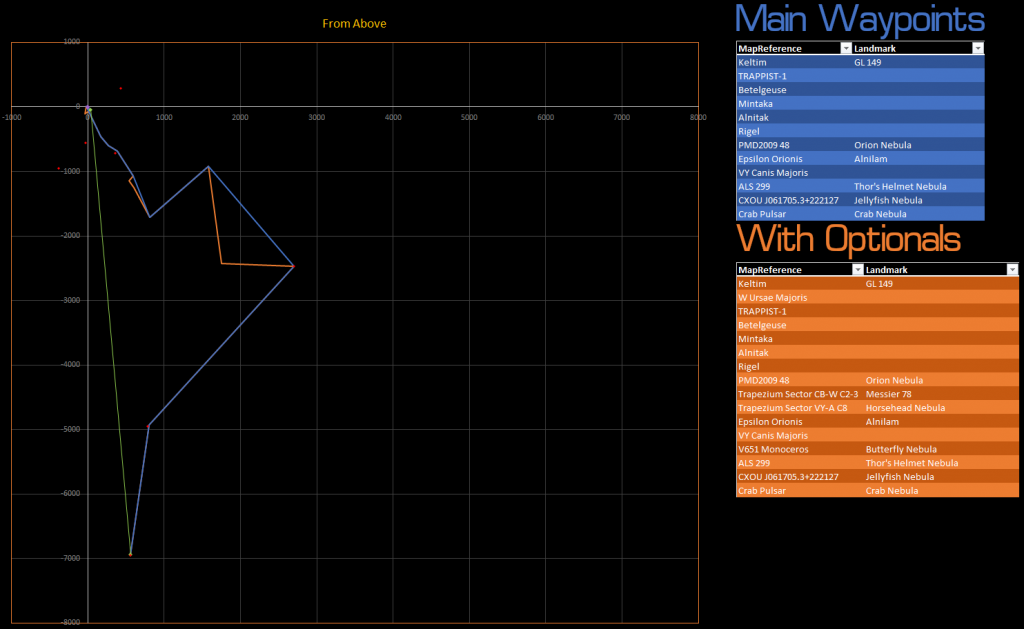We are now launching into our second of 4 legs for Celebration of Early Astronomy 4! This leg doesn’t have too many main waypoints, but there is still plenty to explore in and around each of the places represented by the main waypoints.
Additionally there are some optional waypoints to visit for those interested in the lore of the game’s universe, particularly that of the shadowy group known as “The Club.”
Dates
Start Date: January 22, 2022
End Date: February 5, 2022
Distances
Basecamp Line: 8,332.40 Ly
Main Waypoints: 10,657.41 Ly
Optional Waypoints: 18,186.08 Ly
Map, (click for full size):

Basecamp: Bubble Sector LX-T B3-1
Main Waypoints
- Map References quick reference list, more details below
- BD+46 1067
- Hypoae Ain MO-I D9-37
- RS Persei
- Bubble Sector LX-T B3-1
Main Waypoints Details
- Map Reference: BD+46 1067
- POI: IC 2149
- IC 2149 is a planetary nebula around the star BD+46 1067, discovered by Williamina Felming in 1906. It is located in the sky from Earth within the Auriga constellation. It is hypothesized that the plantery nebula that our own sun will eventually make will be very similar to this particular one. If you are having trouble leaving this waypoint, you can route to IC 2149 Sector DL-Y d0, which is a neutron star. You can route to the next waypoint from there. Note that you may need Jumponium for this.
- SIMBAD Link
- Map Reference: Hypoae Ain MO-I D9-37
- POI: Heart & Soul Nebulae
- This is a pair of nebulae very close to each other. First is the Heart Nebula, aka IC 1805. An emission nebula in the Persues Arm of the Mily Way, and in the Cossiopeia constellation of the sky. Within the nebula is a bright open cluster of stars known as Collinder 26 and contains a few bright stars nearly 50 times the mass of our sun, as well as many more dim stars. The size of the nebula in the night sky is nearly 2 degrees of arc, making it nearly four times the size in the night sky as the full moon.
The second nebula is the Soul Nebula, also known as Westerhout 5. It is also an emission nebula like the Heart Nebula. Near the nebula in the night sky can also be seen the galaxies Maffei 1 and Maffei 2 of the Maffei Group. Soul Nebula is one of the most studied nebula in the field of star formation, due to it’s angle to us and ease of seeing the gas cavities and stellar formation areas allowing sceintists to easily see how gas cavities formed from the stellar winds of a star’s birth compress gasses together from other cavities leading to a chain reaction of stellar formation.
Multiple SIMBAD Links are relevant to this waypoint:- Heart Nebula: https://simbad.u-strasbg.fr/simbad/sim-basic?Ident=Heart+Nebula
- Soul Nebula: http://simbad.u-strasbg.fr/simbad/sim-basic?Ident=Sh+2-199
- Collinder 26: http://simbad.u-strasbg.fr/simbad/sim-basic?Ident=Collinder+26
- Maffei Group: http://simbad.u-strasbg.fr/simbad/sim-basic?Ident=Maffei+Group
- SIMBAD Link
- Map Reference: RS Persei
- Red Supergiant located in the Double Cluster (Caldwell 14) in the Perseus constellation. In the game galaxy version it is orbited by a landable planet so close that you can fuel scoop while in orbital flight.
There is a bountiful count of other real world celestial objects nearby as well. - SIMBAD Link
- Red Supergiant located in the Double Cluster (Caldwell 14) in the Perseus constellation. In the game galaxy version it is orbited by a landable planet so close that you can fuel scoop while in orbital flight.
- Map Reference: Bubble Sector LX-T B3-1
- POI: Bubble Nebula
- The Bubble Nebula, also known as NGC 7635 is an emission nebula in the Cassiopeia region of the sky. It is formed from stellar wind from the central star BD+60 2522. (For whatever reason however in the in-game galaxy it placed that star nearly 5,000 Ly away from the bubble nebula)
While BD+60 2522 is around two million years old, the Bubble Nebula is only about 40,000 years old. It is hypothesised that the bubble formed as a shock front where stellar wind meets interstellar material at supersonic speeds as the wind from the star travels outwards at between 1,800 to 2,500 kilometers per second.
Multiple SIMBAD links are relevant to this waypoint:- Bubble Nebula: https://simbad.u-strasbg.fr/simbad/sim-basic?Ident=Bubble+Nebula
- BD+60 2522: http://simbad.u-strasbg.fr/simbad/sim-basic?Ident=BD%2B60+2522
Optional Waypoints
- Map References quick reference list, more details below
- BD+46 1067
- Hypoae Ain MO-I D9-37
- RS Persei
- Eafots RA-G B11-0
- Eafots LZ-H B10-0
- Eafots EU-R C4-1
- Eafots GL-Y E2
- Syreadiae JX-F c0
- Bubble Sector LX-T B3-1
Optional Waypoints Details
- Map Reference: Eafots RA-G B11-0
- Body: 3
- AKA: Formidine Rift Gamma Settlement
- One of four lore related abandoned settlements out in the Formidine Rift region related to the lore of The Club. Located on Planet 3.
A badge is able to be unlocked for users of EDSM by visiting any system within the “Eafots” sector, which this system would count for.
- Map Reference: Eafots LZ-H B10-0
- Body: D 1
- POI: Formidine Rift Beta Settlement
- One of four lore related abandoned settlements out in the Formidine Rift region related to the lore of The Club.
A badge is able to be unlocked for users of EDSM by visiting any system within the “Eafots” sector, which this system would count for.
- Map Reference: Eafots EU-R C4-1
- Body: C 2
- POI: Formidine Rift Alpha Settlement
- One of four lore related abandoned settlements out in the Formidine Rift region related to the lore of The Club.
A badge is able to be unlocked for users of EDSM by visiting any system within the “Eafots” sector, which this system would count for.
- Map Reference: Eafots GL-Y E2
- Body: 6
- POI: Formidine Rift Delta Settlement
- One of four lore related abandoned settlements out in the Formidine Rift region related to the lore of The Club.
A badge is able to be unlocked for users of EDSM by visiting any system within the “Eafots” sector, which this system would count for. - EDSM Link
- Map Reference: Syreadiae JX-F c0
- POI: The Zurara
- The Zurara is a lore related abandoned megaship located out here in the Formidine Rift. This can be a bit of a detour from the main leg but if it is of interest to you it’s worth the trip while you’re already in the area. It is related to the lore of the shadowy “The Club.”
Stars become rather sparse along the route from Heart & Soul Nebulae to this system, so make sure you have adequate jump range to make the journey.

